
There is no doubt that the technology behind handheld ultrasound machines is very impressive. Many of the first generations of handheld machines were simply not good enough but there are now several manufacturers raising the bar.
Handheld machines are already improving the accessibility of imaging in the developing world. This is making a significant difference to the healthcare systems of many countries. They are significantly cheaper than a traditional portable or cart based machine. They are easily portable, so can be easily transferred between hospitals/clinics, particularly those in more rural setting.
The portability enables clinicians working between outpatient clinics or wards to easily transport the device in their pocket or handbag. A hospital could buy at least 3-4 handheld machines for the price of one portable or cart based machine. This will significantly improve its accessibility to clinicians.
Handheld machines are not designed for patient after patient scanning. They are intended for clinicians who use ultrasound as an extension of their clinical assessment and not for those working in a radiology department or scanning lists of clients one after another.
But are they good enough for MSK?

We first tried the Clarius (version 1) handheld machine on one of our SMUG courses approximately 4 years ago. Overall the image quality was average, nowhere near the portable GE and Sonosite machines we were regularly using on our courses and in our clinics. The probe was clunky, heavy and overheated quite easily. This was version 1 of the Clarius handheld machine.
“Diagnostic ultrasound is the new stethoscope” - BJSM
This year they have launched the Version 2 (V2) and it looks to have improved in many of the key areas including probe size/weight and image quality. We are also pleased to say they have maintained a very competitive price.
We will go through some of the key features of the Clarius V2:
1/ Probe
The V2 has three probe options; the L7, L15 and the C3 curvilinear probe. We did not review the curvilinear probe but it would not be your first choice for MSK. The L7 being the lower frequency probe and the L15 the higher frequency probe designed for superficial structures. Most MSK structures are 1-4cm so the L15 would appear to be the best option for this. However, the frequency range of the probes are quite similar (L7 = 4-13MHz and the L15 = 5-15MHz). The L7 goes to 11cm, not that you would get a good picture that deep! For general MSK the L15 is the best option.
There is no adjustable focus zone or frequency . Like the SonoSite machines the focus is in the middle of the screen, so you have to adjust the depth accordingly. This works well and is easy to use. You can adjust the near and far gain. The frequency is automatically adjusted by the chosen depth and pre-set. For experienced sonographers not being able to adjust the parameters particularly the frequency is a little frustrating but for a beginner it gives you one less thing to think about! It is very much a ‘point and shoot’ device! Simples!

The design of the V2 is much improved. It is a third lighter than V1 (which is a noticeable difference) and the width of the probe is smaller. Both make the probe far more comfortable to handle. As a wireless device the probe is still significantly heavier and bigger than a conventional probe as it has to house the battery and all the technology! This in unavoidable if you require a wireless device. It is pretty impressive technology to be honest.
Unlike the statement on the website, it does not feel like a normal probe! But it is more comfortable and more like a normal probe then the Version 1. It will still take a bit of getting used to. The probe is pretty robust and is one metre drop tested (it feels solid!) and waterproof to one metre.
The probe itself uses Wi Fi direct (it is inside the probe) and sends the images over a secure channel to a smart device. There were no connection issues. You do not need to be connected to Wi-Fi to scan.
The probe has two easy to use buttons on the side to allow you to freeze and save images/videos without having to use the tablet.
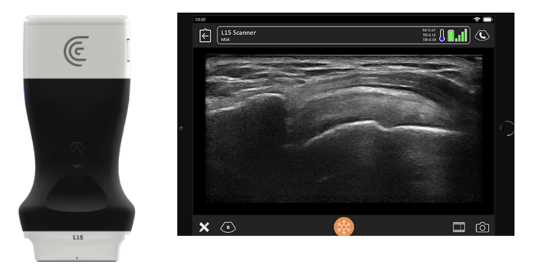
The battery life is approximately 60 minutes but is still prone to getting hot (less so than first version) and will get warm at about 30 minutes. You can get a small fan to clip onto the probe to help with this problem. This is not ideal as it makes the probe bigger but does provide a solution. If you are a clinician e.g. sports doctor or physiotherapist, it is very unlikely that you will scan patient after patient without a break so overheating should not be too much of an issue. However, you will need a second battery (and the charger) in your clinic room to recharge during the day (extra battery £110). One battery at best lasts approximately 45 mins.
What you have to decide is whether a wireless probe is useful in your specific environment. For clinicians working in a busy hospital or those that travel between clinics or with a sports team this maybe an ideal solution. You can keep it in your pocket or bag and carry around a tablet/phone. It avoids trying to find a machine, travel with a larger machine or push a trolley to the ward or outpatient department. However, none of the convenience should be at the detriment of image quality and making the correct diagnosis. For example, we recently reviewed the Butterfly IQ ultrasound machine. It is even smaller and costs less but the machine is not suitable for MSK scanning due to its poor image quality. So, in this case of the Butterfly IQ, the convenience and cost does not outweigh the poor image quality.
2/ Image quality (using L15 probe)
The quality of the image has significantly improved from the first version. The images on any company website look great, but we always like to do our own tests.
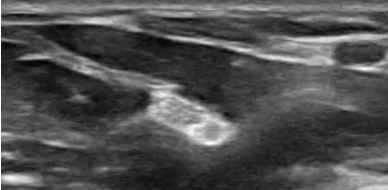

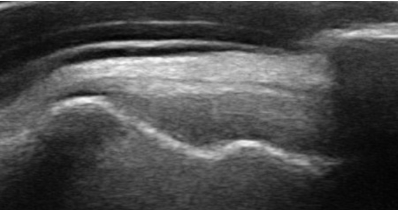

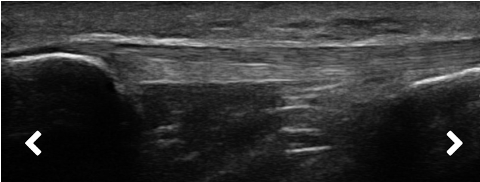



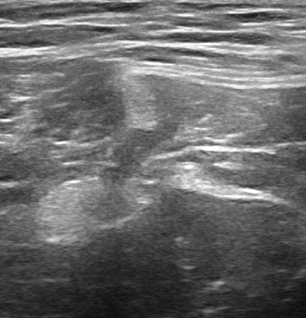

“Image quality is the most important component of a machine”.
With the images above you can make your own mind up. Overall the image quality is good and for a handheld machine under £5000 it is excellent. For superficial structures (< 4cm) it performs very well but does lose some spatial resolution above 4 cm (4-7cm). This is not surprising and should be expected of a machine at this price range.
The image quality is better than the Healcerion Sonon and Butterfly handheld machines. That leaves the Phillips Lumify. Our next blog is going to be a handheld battle between Phillips Lumify and Clarius.
3/ Ease of use – Connectivity and storage
The set-up of the machine is very straight forward and intuitive. It also has a very quick start up i.e. from power on to be ready to carry out a scan. You download the Clarius (free app) for Apple (iOS 11 or later) or Android (4.4.2 - API 19 or greater) and follow the instructions on the screen to connect the device to your phone or tablet. Apple is generally a more stable connection than the Android. You can use as many devices as you want with one scanner e.g. your phone and/or a tablet at each of your clinics. Some of the other handheld machines do limit the number you can connect to.
You can use any Android or Apple phone or tablet. The image on a phone screen is a bit small, whereas on a tablet (the bigger screen the better) the image is far more appealing. Not an image quality thing just a screen size thing!
It is a very easy process to save a scan securely and it uploads automatically onto the Clarius cloud (see image below). You do not pay for this storage (storage is unlimited) unlike other handheld machines. You and/or colleagues can then access these from any device (phone or tablet) or computer. It is a very straight forward intuitive system with a user friendly dashboard and interface. It is also compatible with hospital PACs systems. There is also a useful online community on ‘Clarius Cloud’ for learning and education.

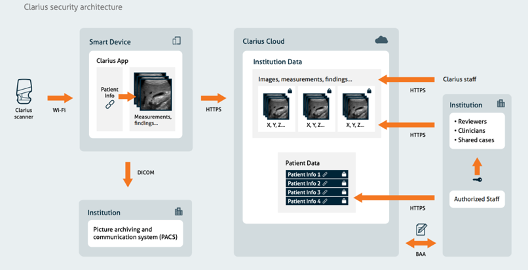
A great feature (which is free) is the Clarius Live (see below) feature. This allows you to carry out a scan and live stream it to a colleague or tutor to provide feedback on the quality of the scan or to assist in diagnosis. It shows the image but you can also view the probe position and probe angle in a split screen. This is a cool piece of technology. The Phillips Lumify have the ‘react’ system which is similar in principle (but we have not tried it).
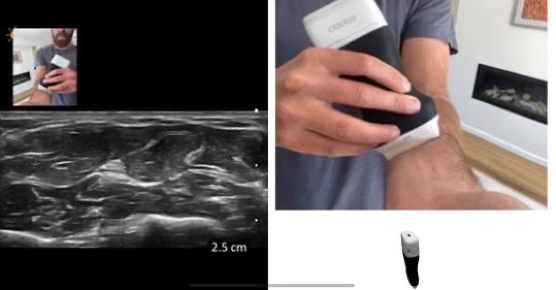
4/ Cost -£4900 (including shipping and VAT)
3-year warranty. No running/subscription costs (unlike other handheld devices). 3-year warranty (lease finance on option).
When we have surveyed our delegates, price is one the most important factors to consider when deciding which machine to buy. As we have said in previous blogs you get what you pay for when it comes to ultrasound machines. This means that generally the more expensive machines provide the best image quality. Image quality is undoubtedly the single most important element of an ultrasound machine, particularly in MSK as the structures we are assessing are very small and prone to anisotropy.
‘You get what you pay for when it comes to ultrasound machines – there is no such thing as a great deal!’
The handheld market is trying to disrupt this mantra. Handheld machines are clearly more affordable and have excellent usability. If they can match the image quality of a portable machine such as the ‘GE Logiq e’ and the ‘SonoSite Edge 2’ (arguably two of the best portable machines) then disrupting the market could become a realistic goal. Many other manufactures will be entering the handheld market in the coming years and investing heavily in research and development. This will become a very competitive market, but as a result better machines will be produced, ultimately improving the diagnostic skills of clinicians and so benefiting patients.
5/ Other specifications on the Clarius V2
Ultrasound guided injections /needle visualisation
We have not had the opportunity to carry out ultrasound guided injections on real patients. The images below are guiding a needle on a meat specimen. The visualisation of the needle (25G and 21G) was good and would be very suitable for straightforward superficial injections such as acromioclavicular and ankle joint and sub-acromial bursa.
Although we have not tried it, the size and weight of the probe would make it tricky to stabilise to inject smaller joints and tendons particularly around the foot and hand. We cannot comment on its ability for deeper injections, such as the hip or shoulder joint injection, but any handheld machine would not be my first choice for this procedure.
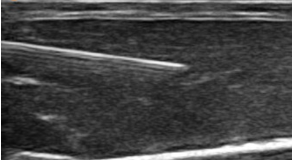
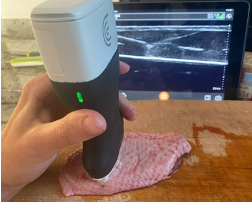

The Clarius Version 2 has needle visualisation as an optional add on (cost approximately £800). Most experienced clinicians will not use needle visualisation so is probably not a necessary add on.
Colour and Power Doppler
These are both a standard feature (no extra charge) and has good sensitivity. We have not had the opportunity to compare the doppler to other handheld machines. When compared to the power Doppler on the SonoSite M-Turbo it had a similar flow but compared to the GE LOGIQe it appeared less sensitive.
Elastography
This is available on the version 2. Elastography gains information of the stiffness and elastic properties of soft tissues. In MSK medicine the stiffness of muscles and tendons would appear to be very important. However, what this information tells us and what to do with this information is still in a research phase. It costs another £800+ and so is probably not essential for most clinicians unless you are involved in these studies.
Conclusion
In conclusion the Version 2 is a significant improvement on Version 1, in terms of image quality, size and shape of probe and functionality. Handheld machines will continue to improve in the coming years and many more will be introduced to the market. For now, the Clarius V2 appears to provide the best image quality of all the handheld machines we have tried. Its competition is the Phillips Lumify. This will be our next SMUG blog!
If you have any questions about this blog or would like to discuss any aspect of ultrasound please contact chris@ultrasoundtraining.co.uk.
For more information about the Clarius handheld machine email Anthony.morris@clarius.com